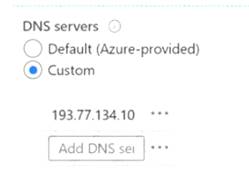Question 91
- (Exam Topic 6)
You have an Azure subscription that contains the Azure virtual machines shown in the following table.
You configure the network interfaces of the virtual machines to use the settings shown in the following table
From the settings of VNET1, you configure the DNS servers shown in the following exhibit.
The virtual machines can successfully connect to the DNS server that has an IP address of 192.168.10.15 and the DNS server that has an IP address of 193.77.134.10.
For each of the following statements, select Yes if the statement is true. Otherwise, select No.
Solution:
Box 1: Yes
You can specify DNS server IP addresses in the VNet settings. The setting is applied as the default DNS server(s) for all VMs in the VNet.
Box 2: No
You can set DNS servers per VM or cloud service to override the default network settings. Box 3: Yes
You can set DNS servers per VM or cloud service to override the default network settings. Reference:
https://docs.microsoft.com/en-us/azure/virtual-network/virtual-networks-faq#name-resolution-dns
Does this meet the goal?
Correct Answer:A
Question 92
- (Exam Topic 5)
You have an Azure subscription.
You plan to use Azure Resource Manager templates to deploy 50 Azure virtual machines that will be part of the same availability set.
You need to ensure that as many virtual machines as possible are available if the fabric fails or during servicing.
How should you configure the template? To answer, select the appropriate options in the answer area.
NOTE: Each correct selection is worth one point.
Solution:
Box 1 = max value Box 2 = 20
Use max for platformFaultDomainCount
* 2 or 3 is max value, depending on which region you are in. Use 20 for platformUpdateDomainCount
Increasing the update domain (platformUpdateDomainCount) helps with capacity and availability planning when the platform reboots nodes. A higher number for the pool (20 is max) means that fewer of their nodes in any given availability set would be rebooted at once.
References:
https://www.itprotoday.com/microsoft-azure/check-if-azure-region-supports-2-or-3-fault-domains-managed-disk https://github.com/Azure/acs-engine/issues/1030
Does this meet the goal?
Correct Answer:A
Question 93
- (Exam Topic 6)
You have an Azure subscription named Subscription1 that contains the quotas shown in the following table.
You deploy virtual machines to Subscription1 as shown in the following table.

Solution:
Does this meet the goal?
Correct Answer:A
Question 94
- (Exam Topic 6)
You have an Azure App Service plan that hosts an Azure App Service named App1. You configure one production slot and four staging slots for App1.
You need to allocate 10 percent of the traffic to each staging slot and 60 percent of the traffic to the production slot.
What should you add to Appl1?
Correct Answer:A
Besides swapping, deployment slots offer another killer feature: testing in production. Just like the name suggests, using this, you can actually test in production. This means that you can route a specific percentage of user traffic to one or more of your deployment slots.
Example:
References:
https://stackify.com/azure-deployment-slots/
Question 95
- (Exam Topic 6)
You have an Azure App Service plan named AdatumASP1 that hosts several Azure web apps. You discover that the web apps respond slowly.
You need to provide additional memory and CPU resources to each instance of the web apps. What should you do?
Correct Answer:D
References:
https://github.com/MicrosoftDocs/azure-docs/blob/master/articles/app-service/web-sites-scale.md Scale up : Correct Choice
Scale up: Get more CPU, memory, disk space, and extra features like dedicated virtual machines (VMs), custom domains and certificates, staging slots, autoscaling, and more. You scale up by changing the pricing tier of the App Service plan that your app belongs to.
Scale out : Incorrect Choice
Scale out: Increase the number of VM instances that run your app. You can scale out to as many as 30 instances, depending on your pricing tier. App Service Environments in Isolated tier further increases yo
scale-out count to 100 instances. For more information about scaling out, see Scale instance count manually or automatically.
Add continuous WebJobs : Incorrect Choice
WebJobs is a feature of Azure App Service that enables you to run a program or script in the same instance a a web app, API app, or mobile app. Add continuous WebJobs will Starts immediately when the WebJob is created. To keep the job from ending, the program or script typically does its work inside an endless loop. If
the job does end, you can restart it.Starts only when triggered manually or on a schedule.
Add a virtual machine scale set : Incorrect Choice
A virtual machine scale set allows you to deploy and manage a set of identical, autoscaling virtual machines. You can scale the number of VMs in the scale set manually. You can also define rules to autoscale based on resource usage such as CPU, memory demand, or network traffic. It will not increase the slowness of the apps.
References:
https://docs.microsoft.com/en-us/azure/app-service/manage-scale-up https://docs.microsoft.com/en-us/azure/app-service/webjobs-create#webjob-types
Question 96
- (Exam Topic 4)
Note: This question is part of a series of questions that present the same scenario. Each question in the series contains a unique solution that might meet the stated goals. Some question sets might have more than one correct solution, while others might not have a correct solution.
After you answer a question in this section, you will NOT be able to return to it. As a result, these questions will not appear in the review screen.
You have an Azure Active Directory (Azure AD) tenant named Adatum and an Azure Subscription named Subscription1. Adatum contains a group named Developers. Subscription1 contains a resource group named Dev.
You need to provide the Developers group with the ability to create Azure logic apps in the Dev resource group.
Solution: On Dev, you assign the Logic App Contributor role to the Developers group. Does this meet the goal?
Correct Answer:A
The Logic App Contributor role lets you manage logic app, but not access to them. It provides access to view, edit, and update a logic app.
References:
https://docs.microsoft.com/en-us/azure/role-based-access-control/built-in-roles https://docs.microsoft.com/en-us/azure/logic-apps/logic-apps-securing-a-logic-app